Management Theory and Practice: Historical Development and Evolution
VerifiedAdded on 2023/01/13
|10
|3115
|20
Essay
AI Summary
This essay provides a comprehensive overview of the evolution of management theory and practice, tracing its development from pre-industrial times through the industrial and post-industrial eras. It begins by examining early management practices, including the influence of Adam Smith and the rise of craft guilds. The essay then delves into the impact of the industrial revolution, highlighting the emergence of scientific management, administrative management, and bureaucratic organization theories. It discusses the contributions of key figures like Frederick Winslow Taylor, Henri Fayol, and Max Weber, and the development of operational management. Furthermore, the essay explores the post-industrial era, focusing on the roles of managers, motivational theories, and the rise of neo-classical management. It also examines the emergence of human resource management and the contributions of Mary Parker Follett and Elton Mayo. The essay concludes by providing a detailed analysis of how management practices have evolved over time and their impact on businesses.
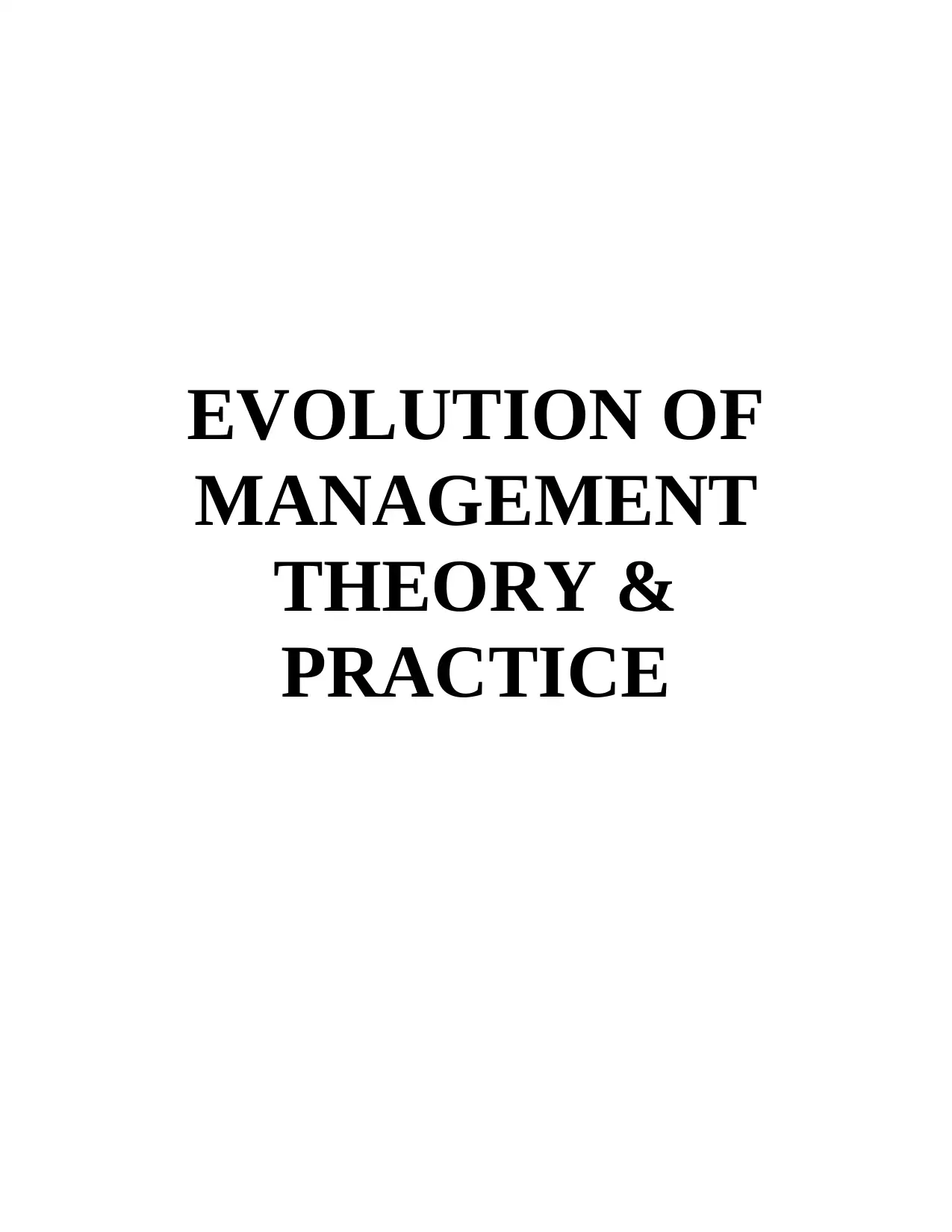
EVOLUTION OF
MANAGEMENT
THEORY &
PRACTICE
MANAGEMENT
THEORY &
PRACTICE
Paraphrase This Document
Need a fresh take? Get an instant paraphrase of this document with our AI Paraphraser
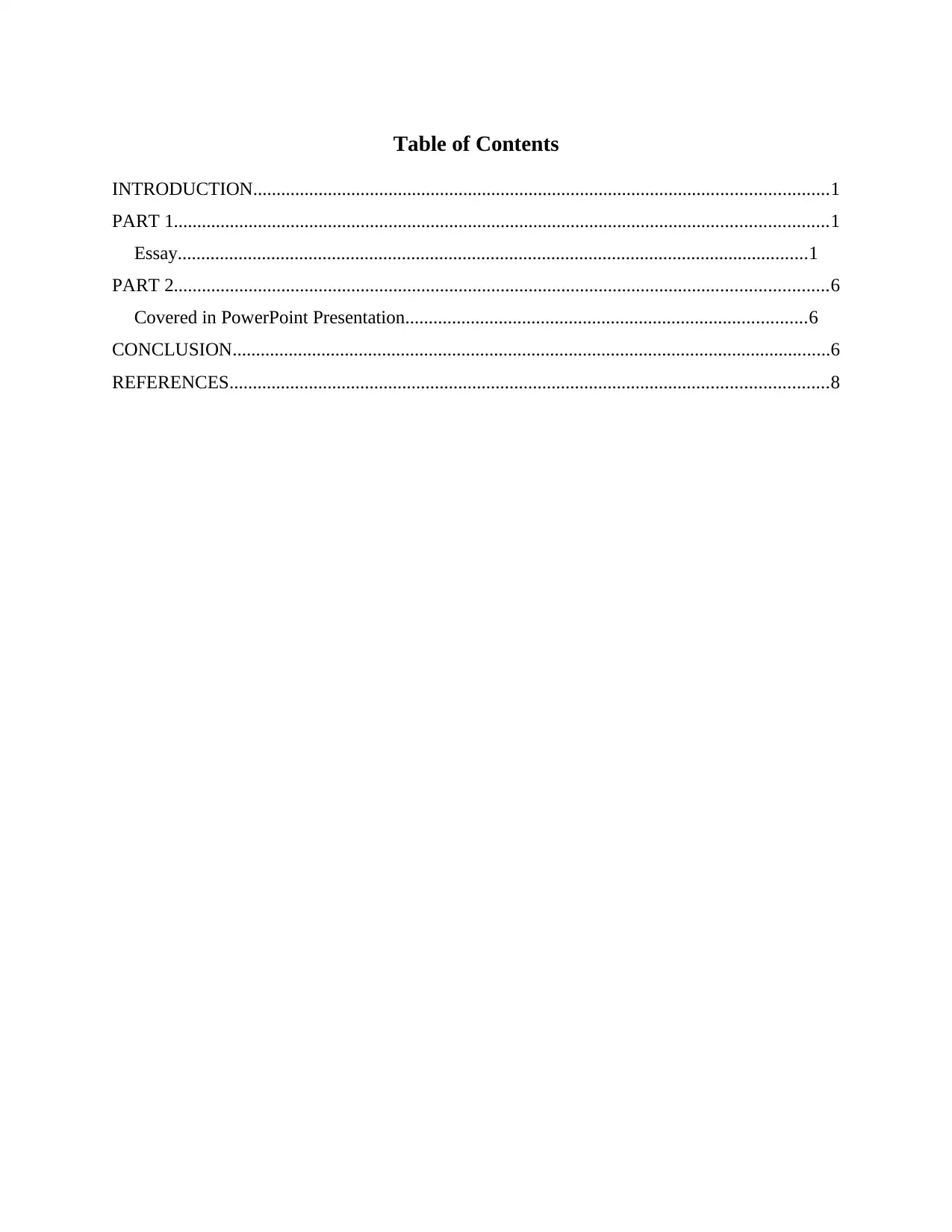
Table of Contents
INTRODUCTION...........................................................................................................................1
PART 1............................................................................................................................................1
Essay.......................................................................................................................................1
PART 2............................................................................................................................................6
Covered in PowerPoint Presentation......................................................................................6
CONCLUSION................................................................................................................................6
REFERENCES................................................................................................................................8
INTRODUCTION...........................................................................................................................1
PART 1............................................................................................................................................1
Essay.......................................................................................................................................1
PART 2............................................................................................................................................6
Covered in PowerPoint Presentation......................................................................................6
CONCLUSION................................................................................................................................6
REFERENCES................................................................................................................................8
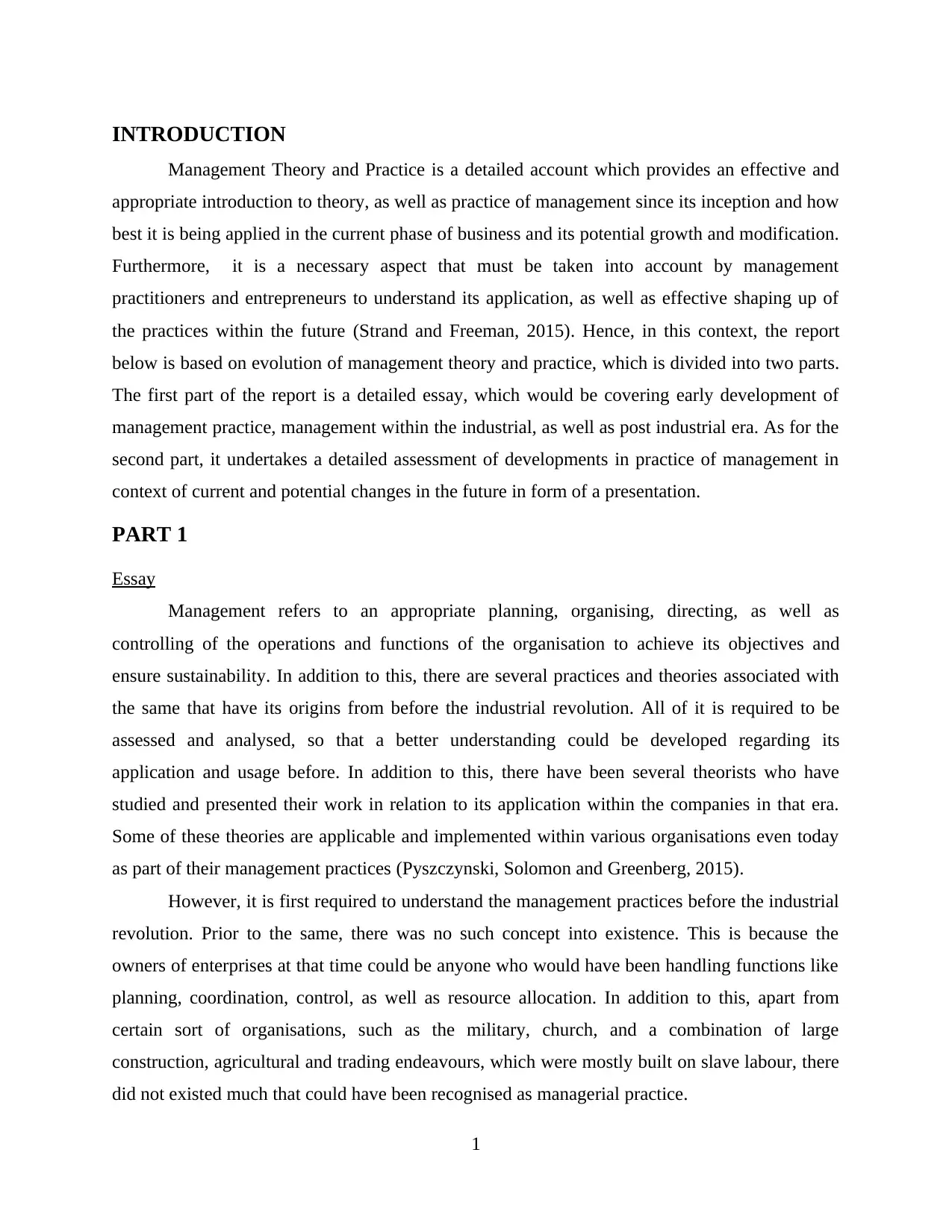
INTRODUCTION
Management Theory and Practice is a detailed account which provides an effective and
appropriate introduction to theory, as well as practice of management since its inception and how
best it is being applied in the current phase of business and its potential growth and modification.
Furthermore, it is a necessary aspect that must be taken into account by management
practitioners and entrepreneurs to understand its application, as well as effective shaping up of
the practices within the future (Strand and Freeman, 2015). Hence, in this context, the report
below is based on evolution of management theory and practice, which is divided into two parts.
The first part of the report is a detailed essay, which would be covering early development of
management practice, management within the industrial, as well as post industrial era. As for the
second part, it undertakes a detailed assessment of developments in practice of management in
context of current and potential changes in the future in form of a presentation.
PART 1
Essay
Management refers to an appropriate planning, organising, directing, as well as
controlling of the operations and functions of the organisation to achieve its objectives and
ensure sustainability. In addition to this, there are several practices and theories associated with
the same that have its origins from before the industrial revolution. All of it is required to be
assessed and analysed, so that a better understanding could be developed regarding its
application and usage before. In addition to this, there have been several theorists who have
studied and presented their work in relation to its application within the companies in that era.
Some of these theories are applicable and implemented within various organisations even today
as part of their management practices (Pyszczynski, Solomon and Greenberg, 2015).
However, it is first required to understand the management practices before the industrial
revolution. Prior to the same, there was no such concept into existence. This is because the
owners of enterprises at that time could be anyone who would have been handling functions like
planning, coordination, control, as well as resource allocation. In addition to this, apart from
certain sort of organisations, such as the military, church, and a combination of large
construction, agricultural and trading endeavours, which were mostly built on slave labour, there
did not existed much that could have been recognised as managerial practice.
1
Management Theory and Practice is a detailed account which provides an effective and
appropriate introduction to theory, as well as practice of management since its inception and how
best it is being applied in the current phase of business and its potential growth and modification.
Furthermore, it is a necessary aspect that must be taken into account by management
practitioners and entrepreneurs to understand its application, as well as effective shaping up of
the practices within the future (Strand and Freeman, 2015). Hence, in this context, the report
below is based on evolution of management theory and practice, which is divided into two parts.
The first part of the report is a detailed essay, which would be covering early development of
management practice, management within the industrial, as well as post industrial era. As for the
second part, it undertakes a detailed assessment of developments in practice of management in
context of current and potential changes in the future in form of a presentation.
PART 1
Essay
Management refers to an appropriate planning, organising, directing, as well as
controlling of the operations and functions of the organisation to achieve its objectives and
ensure sustainability. In addition to this, there are several practices and theories associated with
the same that have its origins from before the industrial revolution. All of it is required to be
assessed and analysed, so that a better understanding could be developed regarding its
application and usage before. In addition to this, there have been several theorists who have
studied and presented their work in relation to its application within the companies in that era.
Some of these theories are applicable and implemented within various organisations even today
as part of their management practices (Pyszczynski, Solomon and Greenberg, 2015).
However, it is first required to understand the management practices before the industrial
revolution. Prior to the same, there was no such concept into existence. This is because the
owners of enterprises at that time could be anyone who would have been handling functions like
planning, coordination, control, as well as resource allocation. In addition to this, apart from
certain sort of organisations, such as the military, church, and a combination of large
construction, agricultural and trading endeavours, which were mostly built on slave labour, there
did not existed much that could have been recognised as managerial practice.
1
⊘ This is a preview!⊘
Do you want full access?
Subscribe today to unlock all pages.

Trusted by 1+ million students worldwide
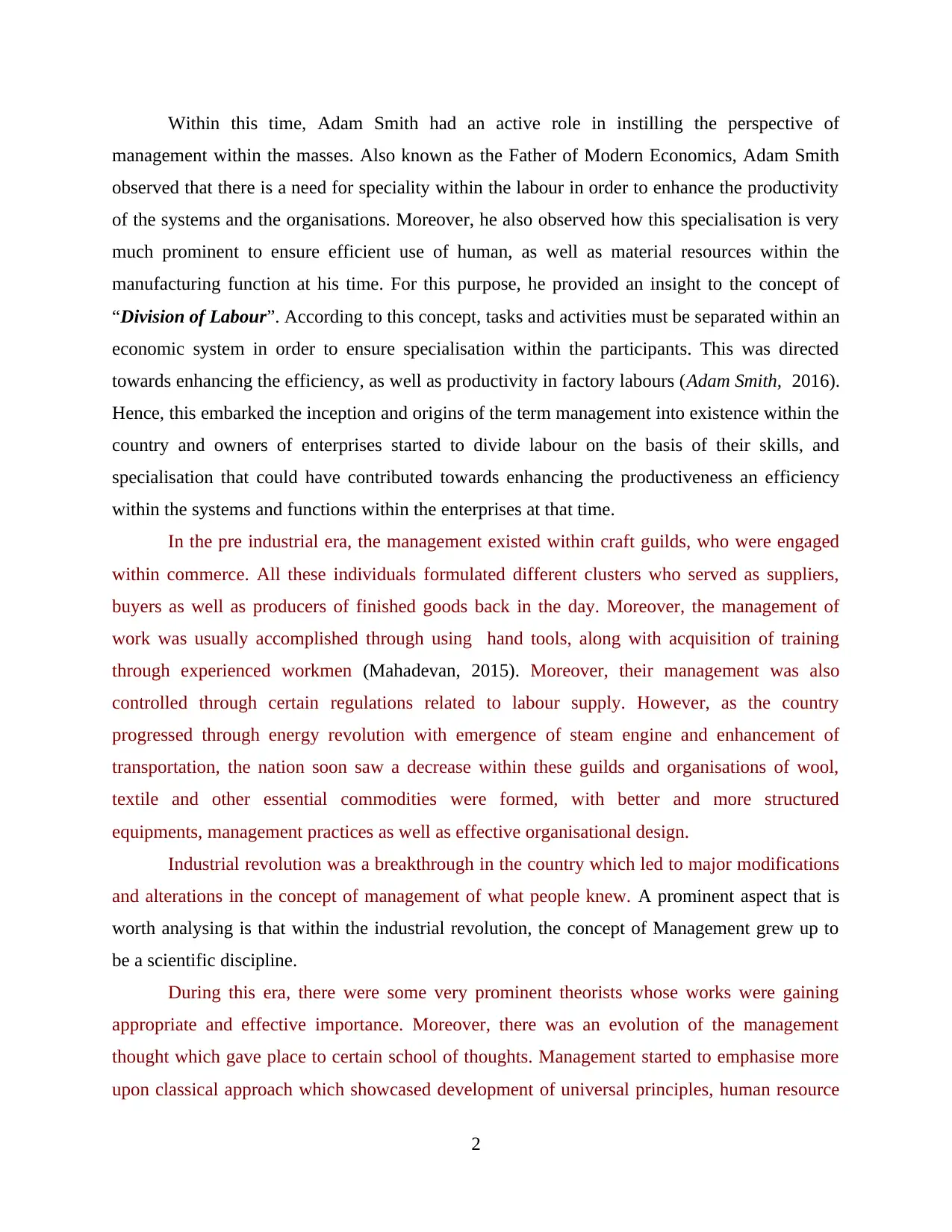
Within this time, Adam Smith had an active role in instilling the perspective of
management within the masses. Also known as the Father of Modern Economics, Adam Smith
observed that there is a need for speciality within the labour in order to enhance the productivity
of the systems and the organisations. Moreover, he also observed how this specialisation is very
much prominent to ensure efficient use of human, as well as material resources within the
manufacturing function at his time. For this purpose, he provided an insight to the concept of
“Division of Labour”. According to this concept, tasks and activities must be separated within an
economic system in order to ensure specialisation within the participants. This was directed
towards enhancing the efficiency, as well as productivity in factory labours (Adam Smith, 2016).
Hence, this embarked the inception and origins of the term management into existence within the
country and owners of enterprises started to divide labour on the basis of their skills, and
specialisation that could have contributed towards enhancing the productiveness an efficiency
within the systems and functions within the enterprises at that time.
In the pre industrial era, the management existed within craft guilds, who were engaged
within commerce. All these individuals formulated different clusters who served as suppliers,
buyers as well as producers of finished goods back in the day. Moreover, the management of
work was usually accomplished through using hand tools, along with acquisition of training
through experienced workmen (Mahadevan, 2015). Moreover, their management was also
controlled through certain regulations related to labour supply. However, as the country
progressed through energy revolution with emergence of steam engine and enhancement of
transportation, the nation soon saw a decrease within these guilds and organisations of wool,
textile and other essential commodities were formed, with better and more structured
equipments, management practices as well as effective organisational design.
Industrial revolution was a breakthrough in the country which led to major modifications
and alterations in the concept of management of what people knew. A prominent aspect that is
worth analysing is that within the industrial revolution, the concept of Management grew up to
be a scientific discipline.
During this era, there were some very prominent theorists whose works were gaining
appropriate and effective importance. Moreover, there was an evolution of the management
thought which gave place to certain school of thoughts. Management started to emphasise more
upon classical approach which showcased development of universal principles, human resource
2
management within the masses. Also known as the Father of Modern Economics, Adam Smith
observed that there is a need for speciality within the labour in order to enhance the productivity
of the systems and the organisations. Moreover, he also observed how this specialisation is very
much prominent to ensure efficient use of human, as well as material resources within the
manufacturing function at his time. For this purpose, he provided an insight to the concept of
“Division of Labour”. According to this concept, tasks and activities must be separated within an
economic system in order to ensure specialisation within the participants. This was directed
towards enhancing the efficiency, as well as productivity in factory labours (Adam Smith, 2016).
Hence, this embarked the inception and origins of the term management into existence within the
country and owners of enterprises started to divide labour on the basis of their skills, and
specialisation that could have contributed towards enhancing the productiveness an efficiency
within the systems and functions within the enterprises at that time.
In the pre industrial era, the management existed within craft guilds, who were engaged
within commerce. All these individuals formulated different clusters who served as suppliers,
buyers as well as producers of finished goods back in the day. Moreover, the management of
work was usually accomplished through using hand tools, along with acquisition of training
through experienced workmen (Mahadevan, 2015). Moreover, their management was also
controlled through certain regulations related to labour supply. However, as the country
progressed through energy revolution with emergence of steam engine and enhancement of
transportation, the nation soon saw a decrease within these guilds and organisations of wool,
textile and other essential commodities were formed, with better and more structured
equipments, management practices as well as effective organisational design.
Industrial revolution was a breakthrough in the country which led to major modifications
and alterations in the concept of management of what people knew. A prominent aspect that is
worth analysing is that within the industrial revolution, the concept of Management grew up to
be a scientific discipline.
During this era, there were some very prominent theorists whose works were gaining
appropriate and effective importance. Moreover, there was an evolution of the management
thought which gave place to certain school of thoughts. Management started to emphasise more
upon classical approach which showcased development of universal principles, human resource
2
Paraphrase This Document
Need a fresh take? Get an instant paraphrase of this document with our AI Paraphraser
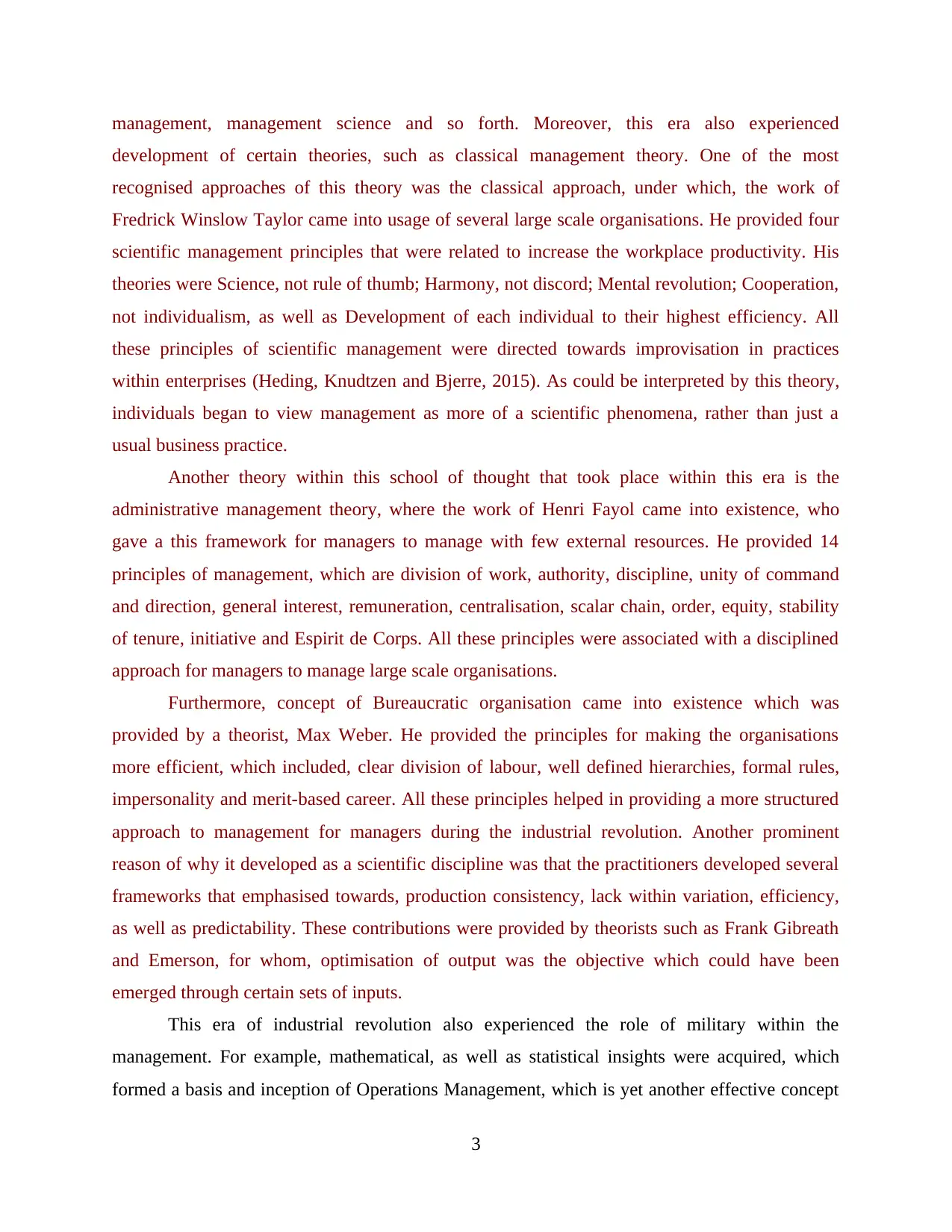
management, management science and so forth. Moreover, this era also experienced
development of certain theories, such as classical management theory. One of the most
recognised approaches of this theory was the classical approach, under which, the work of
Fredrick Winslow Taylor came into usage of several large scale organisations. He provided four
scientific management principles that were related to increase the workplace productivity. His
theories were Science, not rule of thumb; Harmony, not discord; Mental revolution; Cooperation,
not individualism, as well as Development of each individual to their highest efficiency. All
these principles of scientific management were directed towards improvisation in practices
within enterprises (Heding, Knudtzen and Bjerre, 2015). As could be interpreted by this theory,
individuals began to view management as more of a scientific phenomena, rather than just a
usual business practice.
Another theory within this school of thought that took place within this era is the
administrative management theory, where the work of Henri Fayol came into existence, who
gave a this framework for managers to manage with few external resources. He provided 14
principles of management, which are division of work, authority, discipline, unity of command
and direction, general interest, remuneration, centralisation, scalar chain, order, equity, stability
of tenure, initiative and Espirit de Corps. All these principles were associated with a disciplined
approach for managers to manage large scale organisations.
Furthermore, concept of Bureaucratic organisation came into existence which was
provided by a theorist, Max Weber. He provided the principles for making the organisations
more efficient, which included, clear division of labour, well defined hierarchies, formal rules,
impersonality and merit-based career. All these principles helped in providing a more structured
approach to management for managers during the industrial revolution. Another prominent
reason of why it developed as a scientific discipline was that the practitioners developed several
frameworks that emphasised towards, production consistency, lack within variation, efficiency,
as well as predictability. These contributions were provided by theorists such as Frank Gibreath
and Emerson, for whom, optimisation of output was the objective which could have been
emerged through certain sets of inputs.
This era of industrial revolution also experienced the role of military within the
management. For example, mathematical, as well as statistical insights were acquired, which
formed a basis and inception of Operations Management, which is yet another effective concept
3
development of certain theories, such as classical management theory. One of the most
recognised approaches of this theory was the classical approach, under which, the work of
Fredrick Winslow Taylor came into usage of several large scale organisations. He provided four
scientific management principles that were related to increase the workplace productivity. His
theories were Science, not rule of thumb; Harmony, not discord; Mental revolution; Cooperation,
not individualism, as well as Development of each individual to their highest efficiency. All
these principles of scientific management were directed towards improvisation in practices
within enterprises (Heding, Knudtzen and Bjerre, 2015). As could be interpreted by this theory,
individuals began to view management as more of a scientific phenomena, rather than just a
usual business practice.
Another theory within this school of thought that took place within this era is the
administrative management theory, where the work of Henri Fayol came into existence, who
gave a this framework for managers to manage with few external resources. He provided 14
principles of management, which are division of work, authority, discipline, unity of command
and direction, general interest, remuneration, centralisation, scalar chain, order, equity, stability
of tenure, initiative and Espirit de Corps. All these principles were associated with a disciplined
approach for managers to manage large scale organisations.
Furthermore, concept of Bureaucratic organisation came into existence which was
provided by a theorist, Max Weber. He provided the principles for making the organisations
more efficient, which included, clear division of labour, well defined hierarchies, formal rules,
impersonality and merit-based career. All these principles helped in providing a more structured
approach to management for managers during the industrial revolution. Another prominent
reason of why it developed as a scientific discipline was that the practitioners developed several
frameworks that emphasised towards, production consistency, lack within variation, efficiency,
as well as predictability. These contributions were provided by theorists such as Frank Gibreath
and Emerson, for whom, optimisation of output was the objective which could have been
emerged through certain sets of inputs.
This era of industrial revolution also experienced the role of military within the
management. For example, mathematical, as well as statistical insights were acquired, which
formed a basis and inception of Operations Management, which is yet another effective concept
3
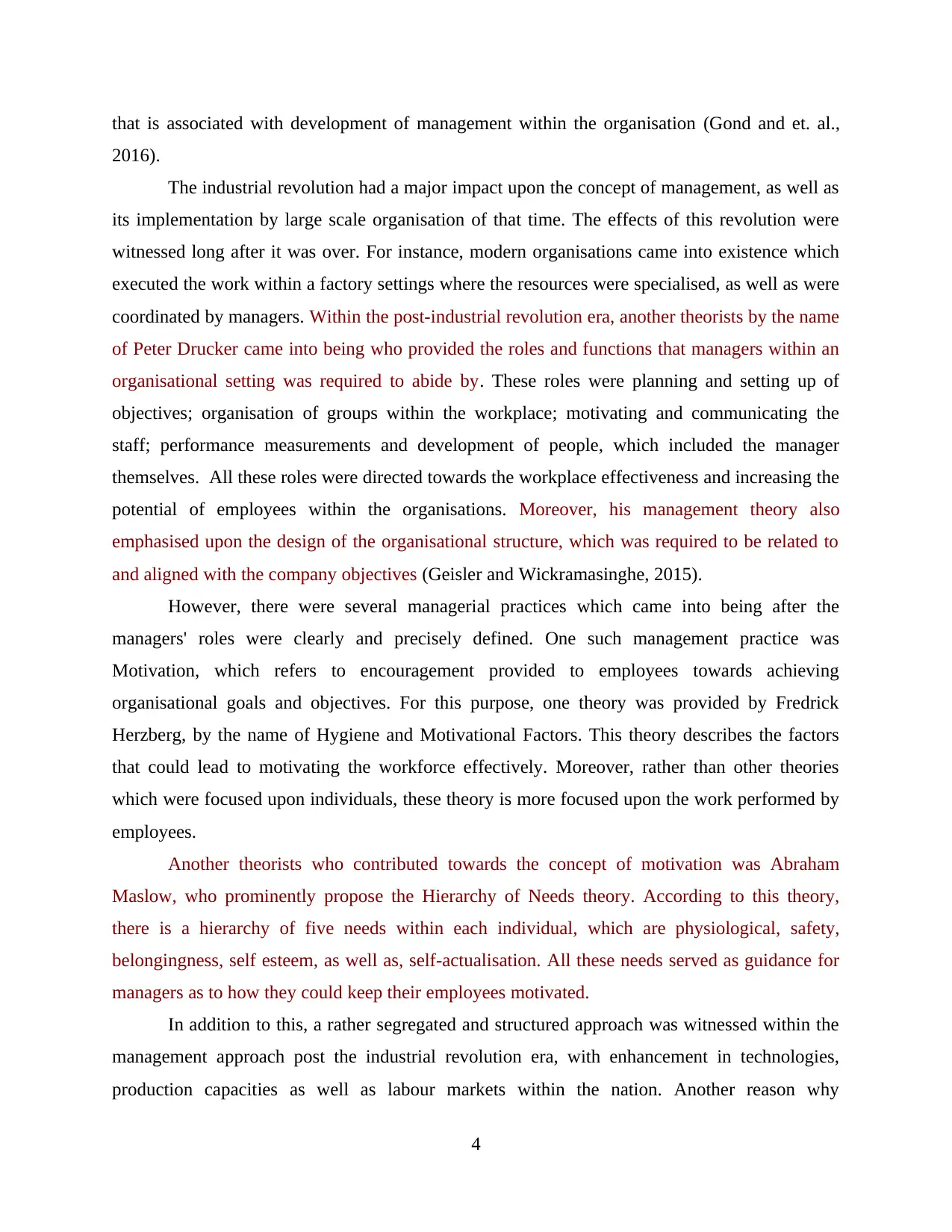
that is associated with development of management within the organisation (Gond and et. al.,
2016).
The industrial revolution had a major impact upon the concept of management, as well as
its implementation by large scale organisation of that time. The effects of this revolution were
witnessed long after it was over. For instance, modern organisations came into existence which
executed the work within a factory settings where the resources were specialised, as well as were
coordinated by managers. Within the post-industrial revolution era, another theorists by the name
of Peter Drucker came into being who provided the roles and functions that managers within an
organisational setting was required to abide by. These roles were planning and setting up of
objectives; organisation of groups within the workplace; motivating and communicating the
staff; performance measurements and development of people, which included the manager
themselves. All these roles were directed towards the workplace effectiveness and increasing the
potential of employees within the organisations. Moreover, his management theory also
emphasised upon the design of the organisational structure, which was required to be related to
and aligned with the company objectives (Geisler and Wickramasinghe, 2015).
However, there were several managerial practices which came into being after the
managers' roles were clearly and precisely defined. One such management practice was
Motivation, which refers to encouragement provided to employees towards achieving
organisational goals and objectives. For this purpose, one theory was provided by Fredrick
Herzberg, by the name of Hygiene and Motivational Factors. This theory describes the factors
that could lead to motivating the workforce effectively. Moreover, rather than other theories
which were focused upon individuals, these theory is more focused upon the work performed by
employees.
Another theorists who contributed towards the concept of motivation was Abraham
Maslow, who prominently propose the Hierarchy of Needs theory. According to this theory,
there is a hierarchy of five needs within each individual, which are physiological, safety,
belongingness, self esteem, as well as, self-actualisation. All these needs served as guidance for
managers as to how they could keep their employees motivated.
In addition to this, a rather segregated and structured approach was witnessed within the
management approach post the industrial revolution era, with enhancement in technologies,
production capacities as well as labour markets within the nation. Another reason why
4
2016).
The industrial revolution had a major impact upon the concept of management, as well as
its implementation by large scale organisation of that time. The effects of this revolution were
witnessed long after it was over. For instance, modern organisations came into existence which
executed the work within a factory settings where the resources were specialised, as well as were
coordinated by managers. Within the post-industrial revolution era, another theorists by the name
of Peter Drucker came into being who provided the roles and functions that managers within an
organisational setting was required to abide by. These roles were planning and setting up of
objectives; organisation of groups within the workplace; motivating and communicating the
staff; performance measurements and development of people, which included the manager
themselves. All these roles were directed towards the workplace effectiveness and increasing the
potential of employees within the organisations. Moreover, his management theory also
emphasised upon the design of the organisational structure, which was required to be related to
and aligned with the company objectives (Geisler and Wickramasinghe, 2015).
However, there were several managerial practices which came into being after the
managers' roles were clearly and precisely defined. One such management practice was
Motivation, which refers to encouragement provided to employees towards achieving
organisational goals and objectives. For this purpose, one theory was provided by Fredrick
Herzberg, by the name of Hygiene and Motivational Factors. This theory describes the factors
that could lead to motivating the workforce effectively. Moreover, rather than other theories
which were focused upon individuals, these theory is more focused upon the work performed by
employees.
Another theorists who contributed towards the concept of motivation was Abraham
Maslow, who prominently propose the Hierarchy of Needs theory. According to this theory,
there is a hierarchy of five needs within each individual, which are physiological, safety,
belongingness, self esteem, as well as, self-actualisation. All these needs served as guidance for
managers as to how they could keep their employees motivated.
In addition to this, a rather segregated and structured approach was witnessed within the
management approach post the industrial revolution era, with enhancement in technologies,
production capacities as well as labour markets within the nation. Another reason why
4
⊘ This is a preview!⊘
Do you want full access?
Subscribe today to unlock all pages.

Trusted by 1+ million students worldwide
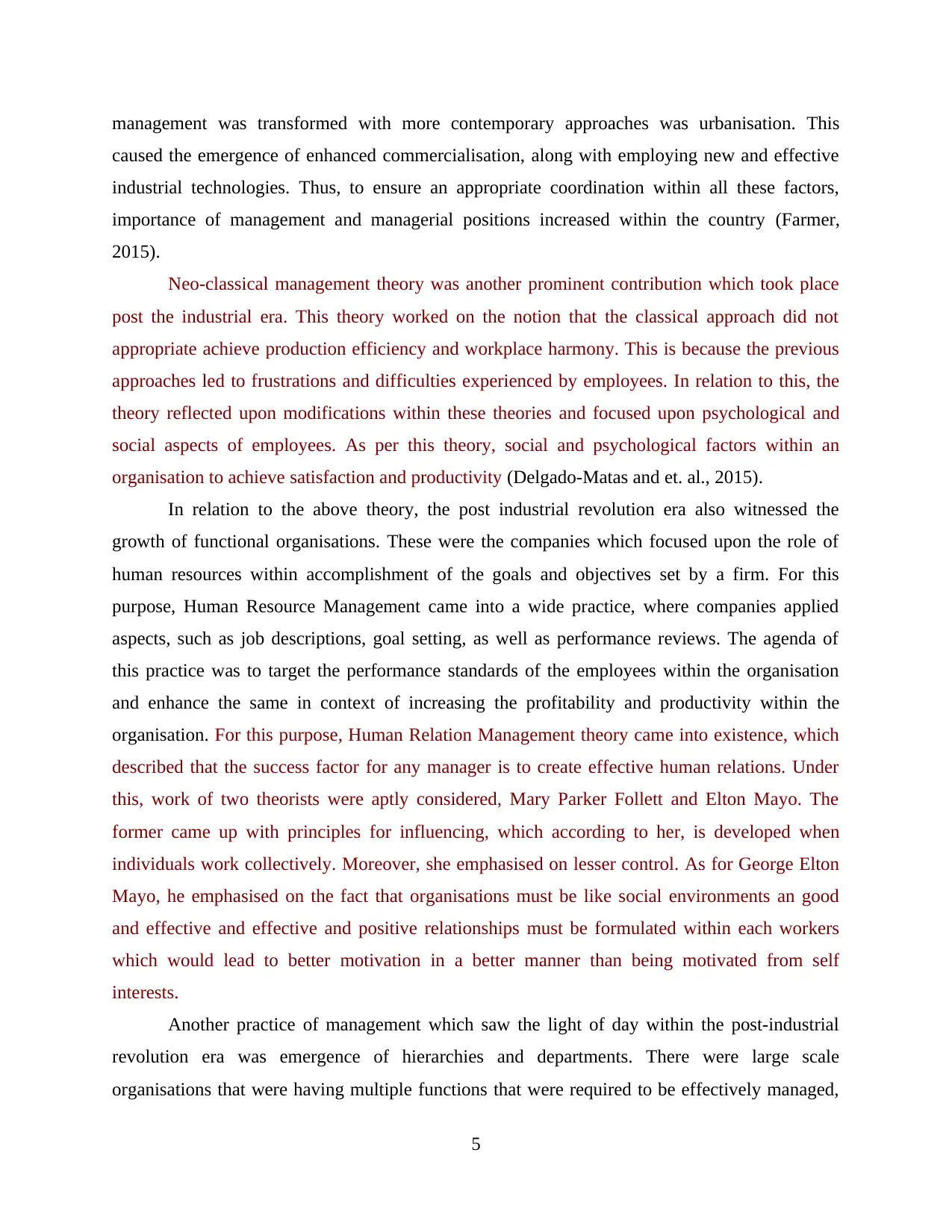
management was transformed with more contemporary approaches was urbanisation. This
caused the emergence of enhanced commercialisation, along with employing new and effective
industrial technologies. Thus, to ensure an appropriate coordination within all these factors,
importance of management and managerial positions increased within the country (Farmer,
2015).
Neo-classical management theory was another prominent contribution which took place
post the industrial era. This theory worked on the notion that the classical approach did not
appropriate achieve production efficiency and workplace harmony. This is because the previous
approaches led to frustrations and difficulties experienced by employees. In relation to this, the
theory reflected upon modifications within these theories and focused upon psychological and
social aspects of employees. As per this theory, social and psychological factors within an
organisation to achieve satisfaction and productivity (Delgado-Matas and et. al., 2015).
In relation to the above theory, the post industrial revolution era also witnessed the
growth of functional organisations. These were the companies which focused upon the role of
human resources within accomplishment of the goals and objectives set by a firm. For this
purpose, Human Resource Management came into a wide practice, where companies applied
aspects, such as job descriptions, goal setting, as well as performance reviews. The agenda of
this practice was to target the performance standards of the employees within the organisation
and enhance the same in context of increasing the profitability and productivity within the
organisation. For this purpose, Human Relation Management theory came into existence, which
described that the success factor for any manager is to create effective human relations. Under
this, work of two theorists were aptly considered, Mary Parker Follett and Elton Mayo. The
former came up with principles for influencing, which according to her, is developed when
individuals work collectively. Moreover, she emphasised on lesser control. As for George Elton
Mayo, he emphasised on the fact that organisations must be like social environments an good
and effective and effective and positive relationships must be formulated within each workers
which would lead to better motivation in a better manner than being motivated from self
interests.
Another practice of management which saw the light of day within the post-industrial
revolution era was emergence of hierarchies and departments. There were large scale
organisations that were having multiple functions that were required to be effectively managed,
5
caused the emergence of enhanced commercialisation, along with employing new and effective
industrial technologies. Thus, to ensure an appropriate coordination within all these factors,
importance of management and managerial positions increased within the country (Farmer,
2015).
Neo-classical management theory was another prominent contribution which took place
post the industrial era. This theory worked on the notion that the classical approach did not
appropriate achieve production efficiency and workplace harmony. This is because the previous
approaches led to frustrations and difficulties experienced by employees. In relation to this, the
theory reflected upon modifications within these theories and focused upon psychological and
social aspects of employees. As per this theory, social and psychological factors within an
organisation to achieve satisfaction and productivity (Delgado-Matas and et. al., 2015).
In relation to the above theory, the post industrial revolution era also witnessed the
growth of functional organisations. These were the companies which focused upon the role of
human resources within accomplishment of the goals and objectives set by a firm. For this
purpose, Human Resource Management came into a wide practice, where companies applied
aspects, such as job descriptions, goal setting, as well as performance reviews. The agenda of
this practice was to target the performance standards of the employees within the organisation
and enhance the same in context of increasing the profitability and productivity within the
organisation. For this purpose, Human Relation Management theory came into existence, which
described that the success factor for any manager is to create effective human relations. Under
this, work of two theorists were aptly considered, Mary Parker Follett and Elton Mayo. The
former came up with principles for influencing, which according to her, is developed when
individuals work collectively. Moreover, she emphasised on lesser control. As for George Elton
Mayo, he emphasised on the fact that organisations must be like social environments an good
and effective and effective and positive relationships must be formulated within each workers
which would lead to better motivation in a better manner than being motivated from self
interests.
Another practice of management which saw the light of day within the post-industrial
revolution era was emergence of hierarchies and departments. There were large scale
organisations that were having multiple functions that were required to be effectively managed,
5
Paraphrase This Document
Need a fresh take? Get an instant paraphrase of this document with our AI Paraphraser
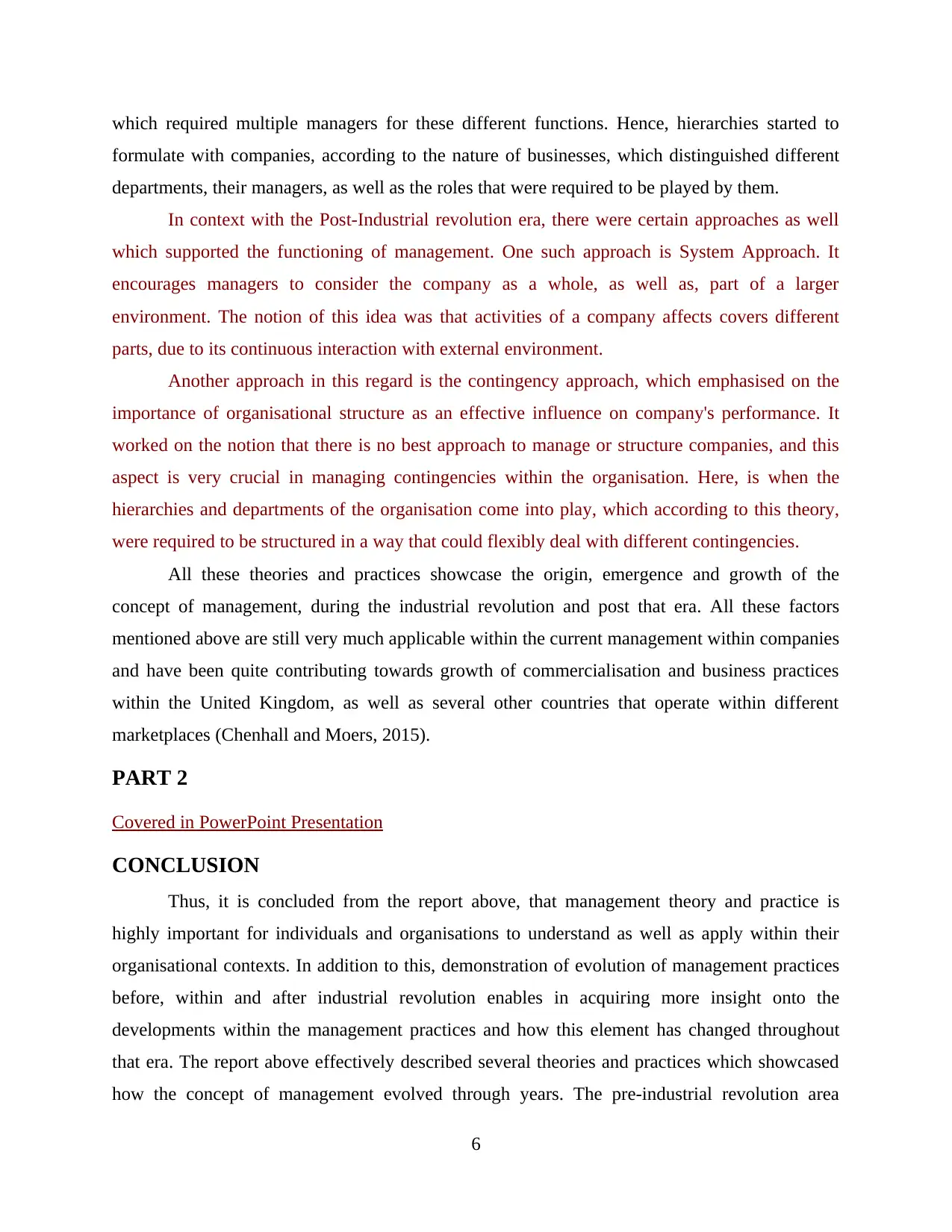
which required multiple managers for these different functions. Hence, hierarchies started to
formulate with companies, according to the nature of businesses, which distinguished different
departments, their managers, as well as the roles that were required to be played by them.
In context with the Post-Industrial revolution era, there were certain approaches as well
which supported the functioning of management. One such approach is System Approach. It
encourages managers to consider the company as a whole, as well as, part of a larger
environment. The notion of this idea was that activities of a company affects covers different
parts, due to its continuous interaction with external environment.
Another approach in this regard is the contingency approach, which emphasised on the
importance of organisational structure as an effective influence on company's performance. It
worked on the notion that there is no best approach to manage or structure companies, and this
aspect is very crucial in managing contingencies within the organisation. Here, is when the
hierarchies and departments of the organisation come into play, which according to this theory,
were required to be structured in a way that could flexibly deal with different contingencies.
All these theories and practices showcase the origin, emergence and growth of the
concept of management, during the industrial revolution and post that era. All these factors
mentioned above are still very much applicable within the current management within companies
and have been quite contributing towards growth of commercialisation and business practices
within the United Kingdom, as well as several other countries that operate within different
marketplaces (Chenhall and Moers, 2015).
PART 2
Covered in PowerPoint Presentation
CONCLUSION
Thus, it is concluded from the report above, that management theory and practice is
highly important for individuals and organisations to understand as well as apply within their
organisational contexts. In addition to this, demonstration of evolution of management practices
before, within and after industrial revolution enables in acquiring more insight onto the
developments within the management practices and how this element has changed throughout
that era. The report above effectively described several theories and practices which showcased
how the concept of management evolved through years. The pre-industrial revolution area
6
formulate with companies, according to the nature of businesses, which distinguished different
departments, their managers, as well as the roles that were required to be played by them.
In context with the Post-Industrial revolution era, there were certain approaches as well
which supported the functioning of management. One such approach is System Approach. It
encourages managers to consider the company as a whole, as well as, part of a larger
environment. The notion of this idea was that activities of a company affects covers different
parts, due to its continuous interaction with external environment.
Another approach in this regard is the contingency approach, which emphasised on the
importance of organisational structure as an effective influence on company's performance. It
worked on the notion that there is no best approach to manage or structure companies, and this
aspect is very crucial in managing contingencies within the organisation. Here, is when the
hierarchies and departments of the organisation come into play, which according to this theory,
were required to be structured in a way that could flexibly deal with different contingencies.
All these theories and practices showcase the origin, emergence and growth of the
concept of management, during the industrial revolution and post that era. All these factors
mentioned above are still very much applicable within the current management within companies
and have been quite contributing towards growth of commercialisation and business practices
within the United Kingdom, as well as several other countries that operate within different
marketplaces (Chenhall and Moers, 2015).
PART 2
Covered in PowerPoint Presentation
CONCLUSION
Thus, it is concluded from the report above, that management theory and practice is
highly important for individuals and organisations to understand as well as apply within their
organisational contexts. In addition to this, demonstration of evolution of management practices
before, within and after industrial revolution enables in acquiring more insight onto the
developments within the management practices and how this element has changed throughout
that era. The report above effectively described several theories and practices which showcased
how the concept of management evolved through years. The pre-industrial revolution area
6
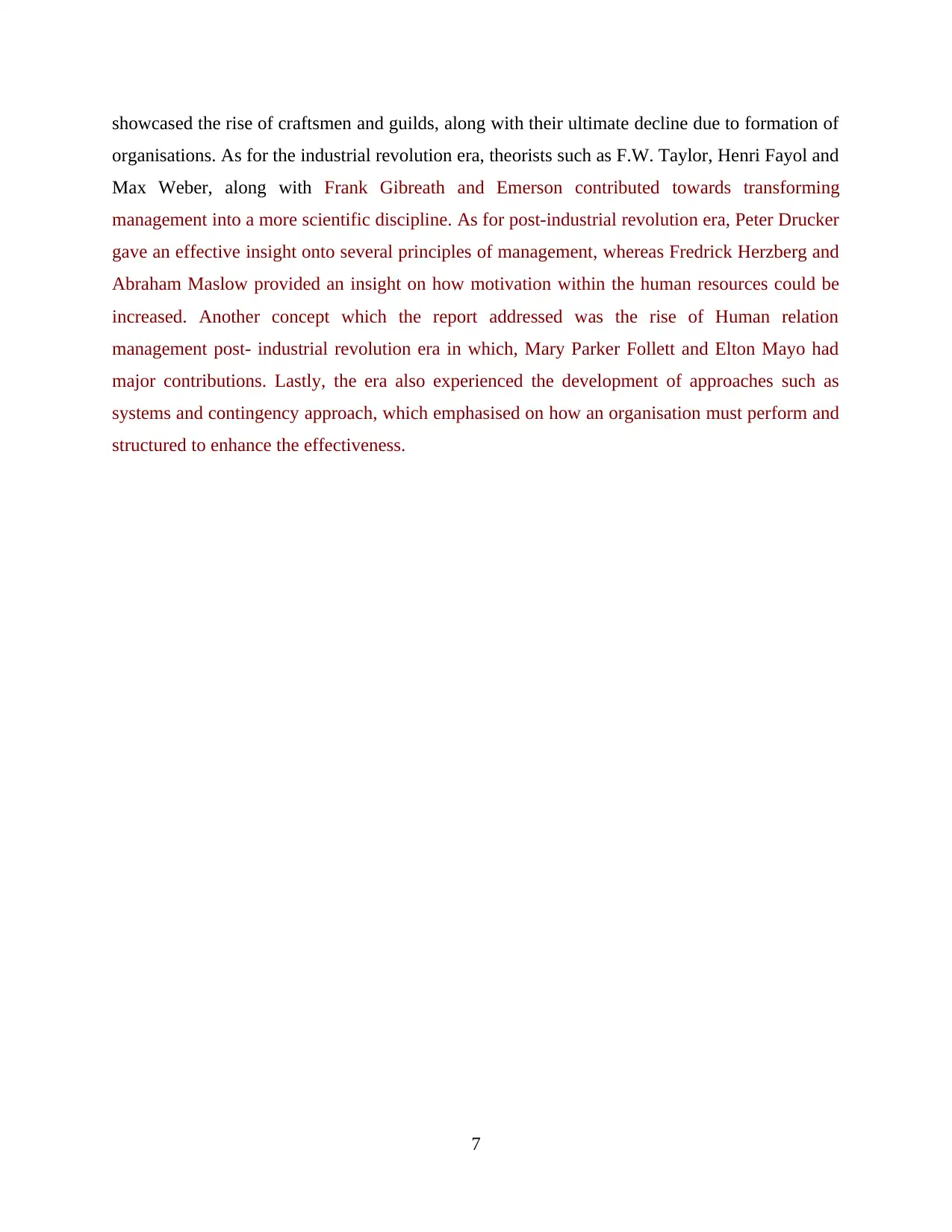
showcased the rise of craftsmen and guilds, along with their ultimate decline due to formation of
organisations. As for the industrial revolution era, theorists such as F.W. Taylor, Henri Fayol and
Max Weber, along with Frank Gibreath and Emerson contributed towards transforming
management into a more scientific discipline. As for post-industrial revolution era, Peter Drucker
gave an effective insight onto several principles of management, whereas Fredrick Herzberg and
Abraham Maslow provided an insight on how motivation within the human resources could be
increased. Another concept which the report addressed was the rise of Human relation
management post- industrial revolution era in which, Mary Parker Follett and Elton Mayo had
major contributions. Lastly, the era also experienced the development of approaches such as
systems and contingency approach, which emphasised on how an organisation must perform and
structured to enhance the effectiveness.
7
organisations. As for the industrial revolution era, theorists such as F.W. Taylor, Henri Fayol and
Max Weber, along with Frank Gibreath and Emerson contributed towards transforming
management into a more scientific discipline. As for post-industrial revolution era, Peter Drucker
gave an effective insight onto several principles of management, whereas Fredrick Herzberg and
Abraham Maslow provided an insight on how motivation within the human resources could be
increased. Another concept which the report addressed was the rise of Human relation
management post- industrial revolution era in which, Mary Parker Follett and Elton Mayo had
major contributions. Lastly, the era also experienced the development of approaches such as
systems and contingency approach, which emphasised on how an organisation must perform and
structured to enhance the effectiveness.
7
⊘ This is a preview!⊘
Do you want full access?
Subscribe today to unlock all pages.

Trusted by 1+ million students worldwide
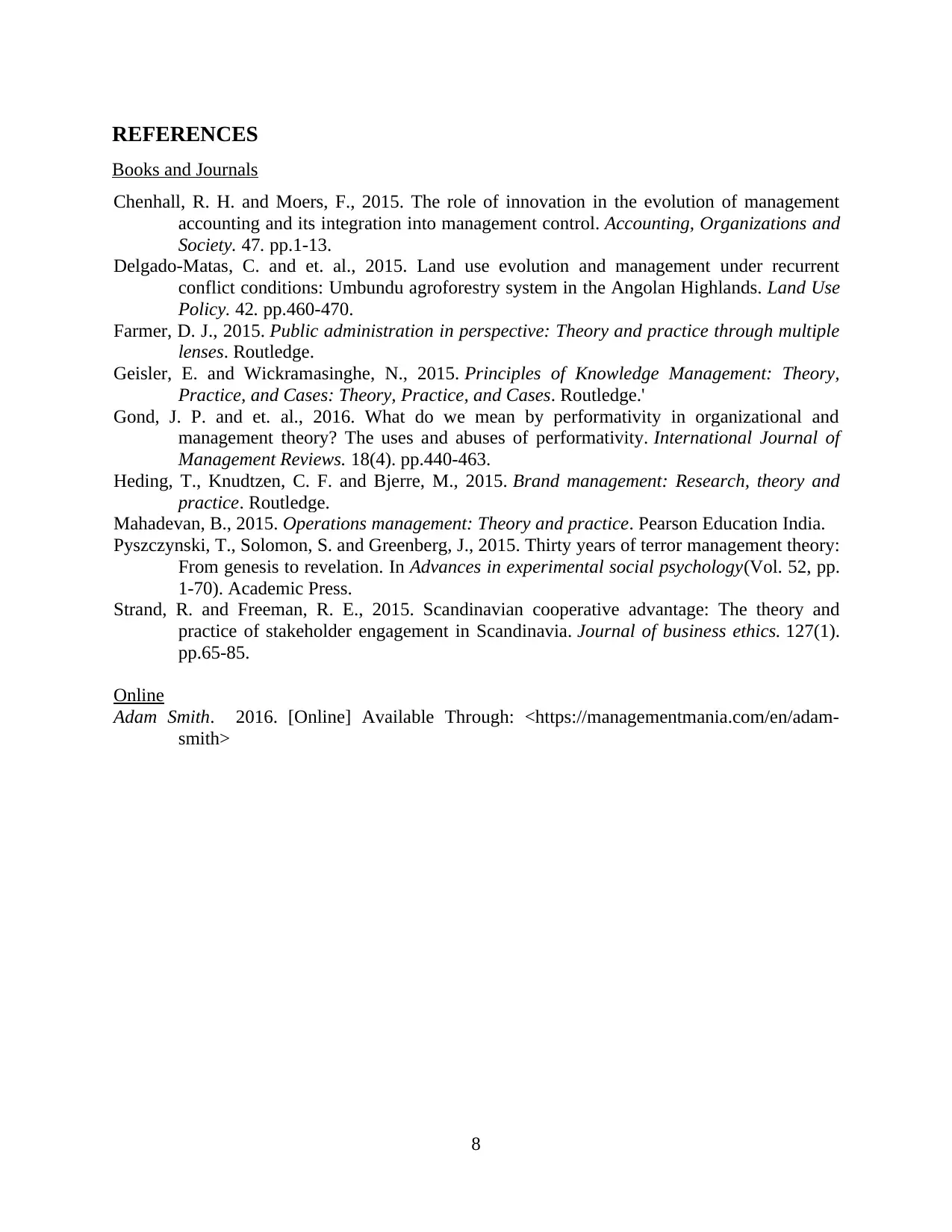
REFERENCES
Books and Journals
Chenhall, R. H. and Moers, F., 2015. The role of innovation in the evolution of management
accounting and its integration into management control. Accounting, Organizations and
Society. 47. pp.1-13.
Delgado-Matas, C. and et. al., 2015. Land use evolution and management under recurrent
conflict conditions: Umbundu agroforestry system in the Angolan Highlands. Land Use
Policy. 42. pp.460-470.
Farmer, D. J., 2015. Public administration in perspective: Theory and practice through multiple
lenses. Routledge.
Geisler, E. and Wickramasinghe, N., 2015. Principles of Knowledge Management: Theory,
Practice, and Cases: Theory, Practice, and Cases. Routledge.'
Gond, J. P. and et. al., 2016. What do we mean by performativity in organizational and
management theory? The uses and abuses of performativity. International Journal of
Management Reviews. 18(4). pp.440-463.
Heding, T., Knudtzen, C. F. and Bjerre, M., 2015. Brand management: Research, theory and
practice. Routledge.
Mahadevan, B., 2015. Operations management: Theory and practice. Pearson Education India.
Pyszczynski, T., Solomon, S. and Greenberg, J., 2015. Thirty years of terror management theory:
From genesis to revelation. In Advances in experimental social psychology(Vol. 52, pp.
1-70). Academic Press.
Strand, R. and Freeman, R. E., 2015. Scandinavian cooperative advantage: The theory and
practice of stakeholder engagement in Scandinavia. Journal of business ethics. 127(1).
pp.65-85.
Online
Adam Smith. 2016. [Online] Available Through: <https://managementmania.com/en/adam-
smith>
8
Books and Journals
Chenhall, R. H. and Moers, F., 2015. The role of innovation in the evolution of management
accounting and its integration into management control. Accounting, Organizations and
Society. 47. pp.1-13.
Delgado-Matas, C. and et. al., 2015. Land use evolution and management under recurrent
conflict conditions: Umbundu agroforestry system in the Angolan Highlands. Land Use
Policy. 42. pp.460-470.
Farmer, D. J., 2015. Public administration in perspective: Theory and practice through multiple
lenses. Routledge.
Geisler, E. and Wickramasinghe, N., 2015. Principles of Knowledge Management: Theory,
Practice, and Cases: Theory, Practice, and Cases. Routledge.'
Gond, J. P. and et. al., 2016. What do we mean by performativity in organizational and
management theory? The uses and abuses of performativity. International Journal of
Management Reviews. 18(4). pp.440-463.
Heding, T., Knudtzen, C. F. and Bjerre, M., 2015. Brand management: Research, theory and
practice. Routledge.
Mahadevan, B., 2015. Operations management: Theory and practice. Pearson Education India.
Pyszczynski, T., Solomon, S. and Greenberg, J., 2015. Thirty years of terror management theory:
From genesis to revelation. In Advances in experimental social psychology(Vol. 52, pp.
1-70). Academic Press.
Strand, R. and Freeman, R. E., 2015. Scandinavian cooperative advantage: The theory and
practice of stakeholder engagement in Scandinavia. Journal of business ethics. 127(1).
pp.65-85.
Online
Adam Smith. 2016. [Online] Available Through: <https://managementmania.com/en/adam-
smith>
8
1 out of 10
Related Documents
Your All-in-One AI-Powered Toolkit for Academic Success.
+13062052269
info@desklib.com
Available 24*7 on WhatsApp / Email
![[object Object]](/_next/static/media/star-bottom.7253800d.svg)
Unlock your academic potential
Copyright © 2020–2025 A2Z Services. All Rights Reserved. Developed and managed by ZUCOL.





